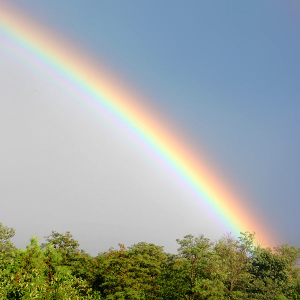Have you ever stopped to marvel at a rainbow arching across the sky after a summer storm? Its vibrant hues, a breathtaking display of nature’s artistry, captivate us with their ethereal beauty. But have you ever wondered what exactly those colors are and why they appear in that specific order? The rainbow, a captivating phenomenon, is a visual testament to the laws of physics and the interplay of light and water droplets. Let’s embark on a journey to unravel the secrets behind this celestial spectacle and understand why it is a source of endless fascination.

Image: www.pinterest.com
The rainbow is more than just a pretty sight; it embodies a profound scientific concept—the phenomenon of light dispersion. This captivating arc of color isn’t a solid object, but rather a visual illusion created by sunlight interacting with water droplets in the atmosphere. Each color we perceive is a specific wavelength of light, and the rainbow’s formation relies on the principle that white light, the light we see from the sun, is actually composed of a spectrum of different colors.
The Science Behind the Rainbow
1. Light Dispersion and Refraction: The Key Players
The journey of a rainbow begins with sunlight, which is made up of a spectrum of wavelengths, each corresponding to a specific color. When a ray of sunlight enters a water droplet, it encounters a change in medium, causing it to bend. This bending is known as refraction, and it occurs because light travels at different speeds in different mediums. The amount of bending depends on the wavelength of light, with shorter wavelengths (like blue) bending more than longer wavelengths (like red).
2. Internal Reflection and Dispersion: A Colorful Symphony
As the sunlight enters the raindrop, it undergoes internal reflection. This means the light bounces off the back of the raindrop, changing its direction. At the same time, the different wavelengths of light are refracted at different angles, creating a separation of colors. This separation is known as dispersion, resulting in the distinct band of colors we recognize as the rainbow.

Image: www.dolorespian.com
The Colors of the Rainbow: A Spectrum of Wonders
1. Red: The Longest Wavelength
Red, the color at the outermost edge of the rainbow, has the longest wavelength within the visible spectrum. The longer wavelengths bend less, allowing red light to exit the raindrop at a steeper angle compared to other colors.
2. Orange: A Warm and Bright Hue
Next comes orange, with a slightly shorter wavelength than red. This color, often associated with warmth and energy, takes its place seamlessly between the fiery red and the vibrant yellow.
3. Yellow: A Symbol of Sunshine and Joy
Yellow, the color of sunshine and optimism, is a cheerful reminder of bright summer days. Its wavelength falls between orange and green, signifying a transition toward the cooler hues of the spectrum.
4. Green: A Blend of Warm and Cool Tones
Green, a color often associated with nature, is a fascinating blend of warm and cool tones. Its wavelength sits between yellow and blue, making it a captivating intermediary in the rainbow’s spectrum.
5. Blue: The Color of the Sky and Ocean
Blue, the color of the vast sky and the deep ocean, is characterized by its shorter wavelength compared to green and yellow. This leads to a greater bending of light, positioning blue closer to the inner edge of the rainbow.
6. Indigo: A Deep and Mysterious Hue
Indigo, a deep and saturated blue, is often difficult to distinguish from violet in a natural rainbow. Its wavelength is slightly shorter than blue, making it a rich and captivating color.
7. Violet: The Shortest Wavelength
Violet, the color at the innermost edge of the rainbow, has the shortest wavelength within the visible spectrum. This leads to the greatest bending of light, causing violet to be positioned closest to the center of the rainbow’s arc.
Beyond the Spectrum: Understanding the Rainbow’s Shape
The rainbow’s shape is a result of the geometry of light interacting with water droplets. To see a rainbow, the sunlight must be behind you, and the raindrops must be in front of you. Each raindrop acts like a tiny prism, dispersing sunlight into its component colors. The different colors then travel in different directions, creating the curved arc we recognize as the rainbow.
Mythology and Symbolism: The Rainbow’s Enduring Legacy
The rainbow has inspired countless myths and legends throughout human history. In many cultures, it is seen as a bridge between the heavens and the earth, a symbol of hope, promise, and divine connection. The “pot of gold at the end of the rainbow” is a popular motif, often signifying luck and fortune.
The Rainbow’s Role in Art and Culture
The beauty and wonder of the rainbow have inspired artists and cultural expressions for centuries. From ancient cave paintings to impressionist masterpieces, the rainbow has been a recurring theme in art. Its vibrant colors have also been adopted in countless flags, symbols, and emblems, representing diversity, unity, and peace.
Observing Rainbows: A Guide to Sky Watching
Rainbows are best seen when the sun is low in the sky, typically during mornings or evenings. Rain showers, coupled with bright sunlight, create the ideal conditions for a rainbow display. Look for a patch of sky opposite the sun, and you’re likely to catch a glimpse of this enchanting spectacle.
What Are The Colors Of A Rainbow
https://youtube.com/watch?v=FIq7kuisdHQ
Conclusion: A Symphony of Light, Color, and Wonder
The rainbow, a mesmerizing phenomenon, is a testament to the intricate mechanics of light and color. Its vibrant hues, a harmonious blend of science and beauty, continue to inspire awe and wonder. By understanding the scientific principles behind its formation, we can appreciate this celestial spectacle even more deeply. So, the next time you see a rainbow, pause for a moment, marvel at its beauty, and remember the fascinating science that creates this wonder of nature.

:max_bytes(150000):strip_icc()/OrangeGloEverydayHardwoodFloorCleaner22oz-5a95a4dd04d1cf0037cbd59c.jpeg?w=740&resize=740,414&ssl=1)




